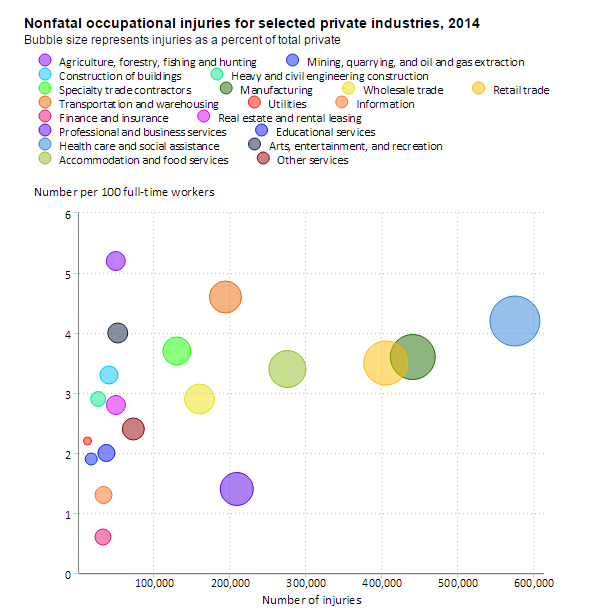It’s that time of year again – on February 1, we will all be posting our OSHA 300A injury/illness summary. Emilcott reviewed this in a recent blog, OSHA Forms, and in following this theme, we thought it might be interesting to look at some of the data provided by the Bureau of Labor Statistics (BLS) about 2014 injury and illness incident rates.
Read MoreEnvironmental Health and Safety Blog | EHSWire
How Do Your Injury Statistics Compare With Other Companies?
Posted by Emilcott Associates
Topics: workplace injuries and illness, OSHA Injury, establishment-specific injury and illness data, annual Occupational Injuries and Illnesses Report, severe work-related injury and fatality reporting, final rule revision to the Injury and Illness Reco, injury, Bureau of Labor Statistics, OSHA Injury and Illness Recordkeeping and Reportin, osha 300, incident rates, industies
OSHA Recordkeeping 300A Its For You and the Rest of the Country!
Posted by Shivi Kakar
Did you know that the OSHA Illness and Injury Summary Log, 300A, is used for more than just recordkeeping at your site? By documenting your companys illness and injuries properly, you shape OSHAs future initiatives! Specifically, OSHA Summary 300A Forms are gathered by the OSHA Data Initiative (ODI) to help direct OSHA programs and measure its own performance.
How does OSHA get this information?
OSHA gets these data from two sources:
- As part of an annual survey, the Bureau of Labor Statistics (BLS) sends injury and illness survey forms to randomly selected employers and uses the information to create the Nation's occupational injury and illness statistics.
- The OSHA Data Initiative mails its annual survey (in June) that collects data on injuries and acute illnesses attributable to work-related activities in private-sector industries from approximately 80,000 establishments in selected high hazard industries. In 2010, OSHA also collected this information from approximately 20,000 establishments in the construction industry in addition to the non-construction establishments. The Agency uses these data to calculate establishment-specific injury/illness rates, and in combination with other data sources, to target enforcement and compliance assistance activities. Traditionally, OSHA collects data from the establishments that meet the following categories, but as we saw in 2010, OSHA can expand these criteria.
- Non-construction industries with 40 or more employees are chosen randomly
- Non-respondents in the previous collection year
- Site with an inspection or consultation visit for performance measurement
- DART rate (days away from work, restriction or transfer) of 7.0 or higher in previous data collection
Does the data really help OSHA?
Now that OSHA has the data from BLS and the ODI, the Agency uses the information to
- Calculate and establish specific injury and illness incidence rates
- Develop targeted intervention programs (i.e., inspections and enforcement action)
- Assist inspectors so that they can direct their efforts to the higher incidents hazards that are hurting workers.
- Measure the success of agency efforts to reduce the number of workplace injuries and illnesses in select high-hazard industries
- Provide the base data for the BLS Annual Survey of Occupational Injuries and Illnesses, the Nation's primary source of occupational injury and illness data.
What is your role?
Be a savvy and educated reporter of your companys illness and injury information. Understanding the OSHA 300 log reporting requirements will ensure an accurate portrayal of worker health and safety as well as maintaining OSHA compliance. Can you answer the following questions?
- How do I complete the OSHA 300 Log and Form 301?
- Am I required to post an OSHA Form 300A ? How do I know if I am exempt?
- What is classified as a work-related illness or injury?
- How do I fill the forms in correctly without over-reporting?
- Do I have to fill in the form if I have no recordable injuries or illnesses in the previous year? What are the rules for posting?
- Once the form is filled in and submitted, if requested by BLS or OSHA, are there other legal requirements I should know?
Not convinced that recordkeeping is important?
Besides providing a visible record of worker safety benchmarks and improvements (or worse, tragedies and reversals), establishments that are requested to but fail to submit a completed data collection form may be subject to OSHA enforcement actions, including the issuance of a citation and assessment of penalties! So, take the time understand OSHAs reporting requirements and implement them correctly it affects your company and the nations workers.
If you need assistance with OSHA recordkeeping, Emilcott offers a variety of ways to help your business stay in compliance from a webinar-based course that outlines the rules and regulations to the development of complete health and safety plans. Or, if you have an OSHA recordkeeping question, just ask us!
Topics: Emilcott, OSHA, health and safety, General Industry H&S, OSHA Compliance, General EHS, Construction H&S, Compliance, worker safety, Occupational Health, Occupational Safety, Webinar, reporting, regulation, Medical Records, BLS, Bureau of Labor Statistics




